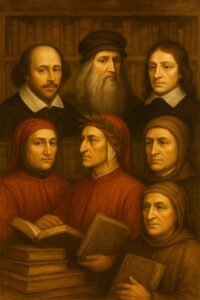What was the Renaissance?
The Renaissance was the movement of transformation of human thought in 17th-century Europe. The movement challenged the traditional principles and medieval theology. In ancient Europe, people were bound with ancient rules and kings’ laws. They were not aware of democracy, fundamental rights, and human dignity. Moreover, women had been treated like slaves because it was a male-dominated society. Perhaps, therefore, European people considered the Renaissance a final hope of freedom.
Renaissance meaning
The literal meaning of “Renaissance” is the rebirth of art, culture, and human thinking perspectives. The movement began in Italy around the 14th century and spread across Europe until the 17th century. The Renaissance can be considered the beginning of a new age of realism, humanism, and prospect. It began in Italy, in art and architecture.
Historical Background of Renaissance Movement
Greece was the center of art, rich culture, and civilized people when Europe was dominated by Middle Ages literature. The Greeks were residing in the city of Constantinople until the Ottoman Empire invaded the city in 1453 AD. The Greeks migrated to Italy with the manuscripts of their great philosophers and scientists, such as Plato, Aristotle, Euclid, and Ptolemy. These texts proved to be the foundation of classical, literary, philosophical, and scientific knowledge for the Italian people. Then, the three great Italian philosophers emerged and translated the Greek works. They translated books and passed them to the next generation.

These three great Italian philosophers were Giovanni Boccaccio (1313–1375), Francesco Petrarch (1304–1374), and Dante Alighieri (1265–1321). These scholars not only translated the Greek books but also used the Greek writing style in their own works; this technique brought a new literary taste among readers.
Renaissance in Italy
- Giovanni Boccaccio
He is best known as a humanist storyteller, and his masterpiece work is “The Decameron,” which is a collection of lively tales about a young man escaping “The Black Death.” He narrates the fear, struggles, and patience of a young man during such unfriendly conditions. Boccaccio also gained access to and helped translate Homer’s Iliad and Odyssey into Latin, the first time those epics had been studied in Western Europe in centuries. His translated works paved the way for Renaissance writers. The translations were in ordinary Italian language, so it was easy for common people to enjoy reading and writing in such a literary style embodying Greek literature elements.
- Francesco Petrarch
Petrarch got inspiration from the rational thoughts and moral virtue of Cicero and Plato. He is also called the father of humanism because he enriched his works with the symbolism of the humanism technique. He rediscovered Greek scholar works, and he wrote works emphasizing the purity of the human spirit and the truth of human nature.
- Dante Alighieri
Dante worked on Christian beliefs and classical Greek and Roman ideas. He fused the three writing techniques in his works and wrote “Divine Comedy.” Dante admired Aristotle and drew on Platonic concepts of the soul and virtue.
These three scholars paved the way for other Italian philosophers like Marsilio Ficino and Leonardo da Vinci. Leonardo da Vinci crafted a lively picture of Mona Lisa that became a subject of interest for kings and queens.
English Renaissance
In the beginning, The invention of the printing press by William Caxton in 1476 helped spread these works rapidly, making literature accessible to the educated middle class for the first time. The great authors of English literature can be considered early Renaissance authors, Sir Thomas More and Sir Thomas Elyot, who believed that studying Greek classical books could make readers wiser, morally active, and true humans. They conveyed and glorified the themes of Greek authors through their works. Sir Thomas More wrote a work named “Utopia” in Latin. He presented and idealized a society built on reason.
Sir Thomas More wrote “”Utopia”—inspired by Plato’s Republic. These two authors emphasized the essence of humanism and encouraged authors to explore and include, in their works, the themes of earthly life, individual experience, and the beauty of language, rather than writing only religious texts. The movement in England began in 1485 and lasted until 1660.
Elizabethan Age (The Golden Age in English Literature)
The Renaissance period reached its peak in the Elizabethan Age. It was the age of literature and art. Europe became the center of art, rich culture, and modern civilization. The Greek and Latin books were translated into English vernacular. Whereas, the translated books of the Greek and Latin philosophers were also included in the school, college, and university syllabus. Students began imitating the Greek and Latin drama technique and successfully adopted the themes of revenge, spirituality, and criticism.
Major Renaissance writers of English Literature
- Shakespeare wrote remarkable plays in this period—Macbeth, Romeo and Juliet, Othello
- Christopher Marlowe: His survival tragedies, like Doctor Faustus and Tamburlaine, project the Renaissance spirit of limitless ambition and thirst for knowledge.
- Sir Philip Sidney wrote the Astrophel and Stella sonnet sequence and The Defence of Poesy, which glorified poetry as the highest expression of human creativity.
Other renowned authors of this period are Edmund Spenser, John Donne, and John Milton, because these authors followed Greek rules and themes in their works.
Key Features of the Renaissance literature
- Humanism—focus on man’s dignity, reason, and potential.
- Individualism—celebration of personal achievement and emotion.
- Classical Learning—revival of Greek and Roman art, thought, and literature.
- Scientific Curiosity—interest in discovery, nature, and the universe.
- Artistic Experimentation—growth of new literary forms: sonnets, blank verse, and drama.
- Patronage and Performance—theaters like The Globe made literature a shared public art.
Legacy of the English Renaissance
The Renaissance transformed English literature from medieval simplicity to modern complexity.
It gave us
- The richest language in world literature,
- The deepest exploration of the human mind, and
- The idea that art and reason can make life meaningful.
From Shakespeare’s stage to Milton’s poetry, the English Renaissance celebrated the power of human imagination—the belief that man, though mortal, could create something eternal through words.